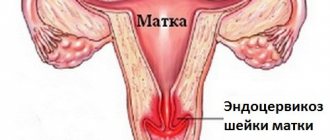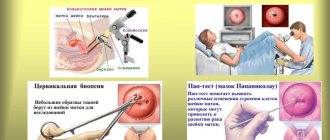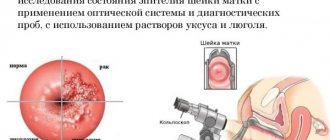Pregnancy does not occur, although there are no obvious reasons for this and all tests are normal? Did you have an ultrasound and the doctor determined that the uterus is bent, the treatment of which requires time and effort? What does the mysterious diagnosis of “retroflexion” in gynecology and its consequences mean? How you can get rid of a bend and posterior displacement of the uterus, what to do, how to get pregnant with a bend and carry a child in this case, we will tell you in this material.
Please note that this is general information about the problem. What therapeutic approach to choose for a successful and quick solution to the problem of uterine retroflexion can only be said after establishing the cause of this condition. For all these questions, we invite women to contact the good gynecologists of our clinic in Moscow - a complete diagnosis of the causes of the appearance and effective treatment using the best, proven techniques!!
What is uterine retroflexion
The bend of the uterus (posterior deviation) is an anomaly in the position of the organ, in which the deviation from the normal position in the pelvis is permanent. It can be congenital or acquired.
The congenital form usually does not cause significant discomfort or problems in a woman’s adult life. More often, the posterior location of the uterus is found in women of asthenic physique, characterized by low weight, thinness and an elongated chest. Often, the causes of retroflexion include a hereditary factor.
Secondary (acquired) posterior bending of the uterus is a consequence of various pathological processes occurring in a woman’s body, which lead to loss of elasticity of the ligaments or to their weakening. The most likely causes of the formation of a bend in the cervix and uterus, according to most obstetricians and gynecologists, are inflammation of the internal genital organs, infections, including some sexually transmitted diseases, surgical interventions “for gynecology” and traumatic childbirth.
Reasons why there is a bend of the uterus
- weak muscles and ligaments of the pelvis;
- a consequence of inflammation of the appendages, untreated or undertreated;
- excessive physical activity;
- tumor processes of the uterus and ovaries;
- gastrointestinal problems;
- adhesions in the pelvic area
- after operations (appendicitis, abortion, caesarean section).
Consequences and complications
In the event that uterine retroflexion is congenital, there is usually no threat to health. If the bend is formed due to previous inflammatory diseases or abortions, then an adhesive process may develop, which can cause infertility and many other female problems. In this case, everything depends on the type and degree of displacement of the uterus (backward, sideways, forward), but there are general symptoms that occur in almost all women. The consequences of retroflexion are usually as follows:
- severe abdominal pain during menstruation;
- periodic fluctuations in the menstrual cycle;
- pain during menstruation, there are blood clots;
- painful sexual intercourse;
- infertility;
- problems with urination.
It should be borne in mind that all of the listed symptoms of uterine retroflexion do not negate the need to use contraception if conceiving a child is not part of your plans at this time.
BEND OF THE UTERUS IN THE PHOTO
Poses when bending the uterus
Is it possible to get pregnant if the uterus is bent backwards? For women with a backward curved uterus, the following postures for conception are best practiced:
- “Knee-elbow” is a good position for conception. It is also called the “dog position” or “doggy style” (English), or in common parlance the more understandable term “doggy style position”. Provides the closest possible contact of the cervix with the penis during friction. After ejaculation in the vagina, a woman is recommended to lie down for 20-30 minutes, preferably on her stomach. Being in a knee-elbow position during intimacy with the uterus bent backwards can reduce discomfort in the abdomen caused by the pressure of the penis on the cervix, and also increases the likelihood of pregnancy.
- Pose “woman on stomach”. The considerations are the same as in the case of the knee-elbow position. In addition to the fact that seminal fluid accumulates in the vagina directly at the cervix, this position also creates conditions for the maximum possible proximity of the uterus and penis, which is also a favorable factor for pregnancy. The leakage of sperm from the vagina, which in some cases occurs in women with a bent uterus posteriorly, to the right, or to the left, is exclusively a manifestation of insufficiency (weakness) of the muscles of the vagina and perineum.
PHOTO “BEST POSITIONS FOR CONCEPTING WHEN THE UTERUS IS DEPENDED”
| Knee-elbow | Knee-thoracic | Knee-hand |
To speed up conception during retroflexion, such positions can also be useful. Intimacy in this position can speed up the onset of pregnancy when the uterus is displaced posteriorly:
How can you get pregnant if your cervix is bent?
As mentioned above, the bend does not affect fertility. Conception is usually hampered by numerous adhesions and inflammatory processes that provoke pathology. But experts say that you can increase the likelihood of conception by having sex in certain positions.
Woman on Top.
The good thing about this position is that the woman can control the depth of penetration and intensity of friction. This will make the sexual intercourse itself comfortable and painless. However, after completing the process, it is recommended to take a horizontal position for at least 5 minutes.
Missionary position (hips up).
The classic missionary position is usually quite painful for a woman with a curve. But when the neck is bent forward, the raised hips will automatically direct the penis into the free pelvic area.
Woman on her stomach (buttocks raised up).
This position is more suitable for those who have retroflexion. It is necessary to lie on your stomach and raise your hips as much as possible so that the penis automatically points to the front of the pelvic area. For comfort, you can place pillows under your stomach.
But taking herbal infusions and medications will not directly affect the correction of the bend. In consultation with your doctor, you can take certain medications to normalize hormonal levels and eliminate possible infections and inflammations. In some cases, surgery may be performed to remove adhesions.
How to treat a bent uterus
As we have already found out above, often the cause of bending is adhesions in the pelvis caused by chronic inflammatory processes in the area of the appendages, STIs or previous gynecological operations. Surgical abortion is also among the likely causes of uterine retroflexion. To get rid of them, in advanced cases, laparoscopy is performed. In case of an infectious nature, anti-inflammatory drugs, antibiotics, etc. are first prescribed.
After the main course of treatment, procedures are needed that will prevent relapse of inflammation and complications, including pathological displacement of the uterus. To do this, according to indications, gynecologists prescribe hormonal drugs or contraceptives according to the scheme, physiotherapy and manual techniques for influencing the female internal genital organs. Among the latter, the leading role in the correction of retroflexion belongs to special massage techniques affecting the pelvic organs in combination with some “folk” methods. In addition to this, physical therapy exercises such as Kegel exercises are considered the best exercises for correcting the mobile pelvic muscles.
Treatment of uterine bending, drugs
About half of cases of uterine flexion do not require treatment. The abnormal location does not prevent conception, and as the fetus grows, the reproductive organ straightens and takes the correct position.
The only recommendation for such pregnant women is to observe a regimen of increased physical activity. We're not talking about jogging, lifting weights or working on your abs. In order to help the uterus get into the anatomically correct position, the expectant mother should pay attention to walking and calm gymnastics for pregnant women, unless there are contraindications for this in the form of a threat of miscarriage or placenta previa.
If the cause of the bending of the uterus is an inflammatory process in the pelvic cavity, then the doctor should prescribe treatment that will help eliminate it:
- Antibacterial drugs - antibiotics in tablets, injections or vaginal suppositories, depending on the severity of inflammation. To determine the most appropriate antibiotic, a special test is first taken from the patient.
- Anti-inflammatory drugs - can be prescribed simultaneously with antibacterial drugs. They will enhance their effect and relieve swelling from the pelvic organs that are affected by the inflammatory process.
- Physiotherapeutic procedures are aimed at reducing adhesive formations that can fix the incorrect position of the uterus. The most common procedure is electrophoresis with the addition of special medicinal drugs that promote the resorption of adhesions.
- Surgical intervention is used extremely rarely, in cases where adhesions are not removed conservatively or if the uterus is severely twisted around its axis, or bent in half.
- Gynecological massage - helps with simple displacement of the reproductive organ and in the event that there is no inflammatory process in the pelvis.
Even a serious bend of the uterus will not interfere with pregnancy if its correction was carried out on time.
What is uterine inflexion
Many women experience a pathology such as displacement of the uterus relative to its natural position in the pelvis. It is located approximately in the center, the cervix enters the vagina. In a normal position, sperm enter the organ cavity through the cervix and from there into the tubes, where fertilization of the egg occurs. If there is a deviation from the norm, the process may be disrupted, and various complications may appear. Their nature depends on the direction in which the bend occurs, as well as on the degree of deviation.
Types of bends
Depending on the direction of the bend, several types of such pathology are distinguished.
Retroflexion. The uterus is pushed back towards the rectum, which is why a woman sometimes fails to conceive a child. This displacement is observed most often. It is this pathology that is usually meant when talking about the occurrence of a bend.
Anteflexion. The uterus is tilted forward towards the bladder. In this case, the cervix is not displaced. This bend is considered a normal variant in nulliparous women. Usually after childbirth the uterus returns to its natural position.
Anteversion. Simultaneous displacement of the uterus and its cervix towards the bladder.
Lateroflexion is a displacement of the organ to the side, towards the right or left ovary.
Another variant of the pathology may be “twisting” of the uterus when it turns around the cervix.
Causes of pathology
The causes of a bent uterus can be:
- congenital disorders of the pelvic organs that arose during fetal development;
- weakening of the muscles and ligaments that hold the uterus in its natural position (for example, due to multiple pregnancies or age-related changes in the body);
- rupture of the muscles and ligaments connecting the organ to the walls of the abdominal cavity;
- the occurrence of adhesions between the body of the uterus and other organs;
- formation and growth of tumors on the outer surface of the uterus;
- inflammatory processes leading to the formation of scars and changes in the shape of the organ;
- diseases associated with hormonal disorders (endometriosis, cysts and ovarian tumors);
- abortions, surgical interventions, caesarean section;
- abdominal injuries;
- lifting weights, intense sports during menstruation;
- frequent births, especially difficult ones;
- sudden weight loss;
- intestinal diseases, as well as bladder tumors.
Prevention
To prevent the occurrence of inflection, doctors advise excluding abortions, curing all pathologies of the genitourinary tract, and avoiding one-time sexual intercourse and unprotected sex. If a woman has undergone surgery in the abdominal area, the local gynecologist will advise the most appropriate methods to prevent the formation of adhesions.
A bent uterus is a serious problem that cannot be solved on your own. An annual visit to the gynecologist will give you a chance to detect changes in a timely manner, before serious complications develop. Here's a video about what uterine inflection is:
Symptoms of a bent uterus
The first signs that suggest that a woman has a uterine inflexion may be a violation of the regularity of menstruation, increased pain during menstruation and during sexual intercourse. In addition, if the uterus is tilted forward, there is a frequent urge to urinate.
A symptom of the occurrence of a bend may be an increase in the intensity of menstrual flow, the formation of clots of coagulated blood in it. The duration of menstruation increases due to spotting. Delays may occur due to impaired cervical patency due to bending.
When the uterus is bent, leucorrhoea of a yellowish or greenish color with an unpleasant odor often occurs. Their appearance indicates stagnation of mucus and the presence of a bacterial infection.
Compression of the intestines when a bend occurs leads to constipation and gas incontinence. Urination becomes more frequent.
Symptoms of the disease
Most often, the pathology does not make itself felt by the manifestation of any symptoms. The severity of symptoms depends on the type of bend. Most often, symptoms appear with a fixed bend, especially if an inflammatory process occurs in parallel.
One of the very first symptoms with which women consult a doctor is reproductive dysfunction. In this case, the bend or previously formed adhesions prevent sperm from entering the cervical canal.
In addition to this symptom, women may experience:
- The appearance of heaviness and pain during sexual intercourse. The pain may not be present all the time, but only when using certain poses.
- Increased pain during menstruation, which is concentrated in the lumbar region.
- Heavy discharge, sometimes in the form of clots or, conversely, a decrease in the volume of discharge during menstruation.
- Disorders of the genitourinary system, which appear as a result of pressure on the bladder by a displaced uterus. In this case, there will be a frequent urge to urinate, which will be accompanied by pain. As a result, cystitis may develop.
- Intestinal dysfunction due to additional pressure from the uterus. This provokes difficulty in emptying and discomfort during this process.
Possible complications when the uterus is bent
When a bend of the uterus forms, the consequences are associated both with disruption of its functioning and with the impact on neighboring pelvic organs.
Menstrual irregularities (changes in the duration and nature of menstruation) are possible. The danger of pathologies (inflammatory processes, endometrial hyperplasia) increases.
Due to the bending of the uterus forward or backward, compression of the rectum or bladder occurs, which affects the functioning of these organs and complicates defecation or urination.
Deflection of the uterus and pregnancy
With a slight bend of a congenital or acquired nature, problems with the onset of conception, as a rule, do not occur if there are no other pathologies. During pregnancy, the uterus stretches, its position becomes more natural. Changes in shape and size can lead to the disappearance of pathology after childbirth.
If a significant bend occurs, the opening of the cervix rests against the vaginal wall, which makes it difficult or impossible for sperm to penetrate into it. The consequence is the woman's infertility. The same complication occurs if there is an inflection at the base of the uterine body. In this case, after sexual intercourse, sperm is retained in the vagina.
In many cases, pregnancy if a woman has a bent uterus becomes possible due to partial or complete restoration of its position relative to the vagina. Conceiving can be helped by a woman choosing the correct position during sexual intercourse, eliminating the bend with the help of a special massage and other measures recommended by the doctor.
If pregnancy has occurred, complications are most likely to occur if the uterus is tilted back. In this case, spontaneous abortion is possible. During childbirth, it becomes difficult for the cervix to open and the baby to pass through the birth canal, which threatens fetal hypoxia and injury. In some cases, the birth of a child is only possible through cesarean section.
Pregnant women who have a pathology such as bending are recommended to practice yoga and therapeutic exercises to strengthen the ligaments and muscles of the pelvis. Exercises often help correct the position of the uterus if there are no adhesions in the abdominal cavity. The presence of adhesions significantly complicates the course of pregnancy, since the growth of the fetus causes displacement of other organs. A so-called “strangulation” of the uterus occurs, which often ends in miscarriage.
Video: Possibility of pregnancy when the uterus is bent. Features of the course
https://youtu.be/uAx1eJ_HkEo
Why is a bent uterus dangerous?
If the pathology is congenital, then there is no threat at all. This can be considered such a small feature, but if something caused its occurrence and you are accompanied by constant pain (during menstruation, sex, etc.), then you should sign up for a gynecological examination and undergo an individual course of treatment. If, in addition to painful sensations, you are worried about difficulties with pregnancy (problems with conception, a difficult pregnancy process, difficulties with childbirth, the uterus is posterior during pregnancy), you definitely cannot do without a doctor, and you do not need to endure or wait it out.
Diagnostic and treatment methods
The bend is often diagnosed during a routine gynecological examination. To clarify the nature and extent of deviations, ultrasound of the pelvic organs is used, as well as hysterosalpingography (x-ray of the uterus using a contrast solution), which makes it possible to detect the cause of obstruction of the fallopian tubes.
To determine the cause of uterine flexion and assess possible complications, laboratory methods for examining blood and vaginal smears, biopsy (taking tissue samples for microscopic examination), and colposcopy are used.
The following methods for eliminating bends are used:
- drug treatment to speed up the resorption of adhesions;
- elimination of diseases that caused the organ to deviate from its normal position (hormonal therapy, anti-inflammatory treatment, physiotherapy);
- carrying out activities that help strengthen muscles and ligaments (physical therapy, Pilates classes);
- restorative treatment with vitamins.
A special gynecological massage allows you to correct the position of the organ.
In some cases, surgical treatment methods are used. For example, adhesions are removed using laparoscopy.
The uterus is often fixed by installing a pessary (a special ring that fixes it in the correct position). It is installed for a certain time and is removed after the tilt is eliminated.
Sometimes a method is used in which the doctor manually corrects the position of the organ. In this case, general anesthesia is used.
Treatment
Photo: vitabirsk.ru
Since a slight degree of uterine bending does not bring any discomfort to the woman, treatment is not performed. In this case, the gynecologist, as a rule, recommends refraining from intense physical activity and sudden lifting of weights. In addition, the uterus occasionally returns to its normal position during pregnancy or after childbirth.
Medicines are prescribed in the case of the presence of an inflammatory disease that is the cause of the development of the pathology in question. In such cases, the following groups of drugs are used:
- antibacterial agents, the action of which is aimed at destroying pathogenic microflora;
- anti-inflammatory drugs that reduce the severity of the inflammatory process;
- vitamin or vitamin-mineral complexes necessary to restore the body’s protective properties.
Non-drug treatment methods include physical therapy, which trains the muscles of the perineum. To achieve this effect, special exercises are being developed that can be successfully performed at home. Gynecological massage is also prescribed, the effect of which is to improve blood circulation to structures located in the pelvis. In addition, it is believed that in the presence of adhesions, the use of gynecological massage can increase the elasticity of adhesions, which has a beneficial effect on the position of the uterus. Additionally, physiotherapeutic procedures may be prescribed. For the pathology under consideration, the following are used:
- electrophoresis is a physiotherapeutic method of treatment that involves administering a medicinal product to the tissue of the human body, carried out using a direct electric (galvanic) current;
- ultraphonophoresis is a physiotherapeutic procedure that is based on the effect of ultrasound on the human body in combination with medicinal substances;
- diadynamic currents – a method of physiotherapeutic treatment based on exposure to electric current with a frequency of 50 – 100 Hz;
In severe cases, when all of the above treatment methods do not bring the desired effect, surgical intervention is resorted to help. During the operation, adhesions are dissected, after which the uterus is fixed in a physiological position. Surgery is also performed in the presence of a neoplasm, the elimination of which allows you to get rid of the existing problem.
Doctors' recommendations
They boil down to the fact that women should not lift weights or be in a standing position for a long time. Participation in certain sports associated with tension in the pelvic muscles (strength exercises, prolonged cycling) is harmful.
You cannot endure the urge to urinate and have bowel movements for a long time. It is useful to sleep on your stomach. It is recommended to perform special exercises to strengthen the muscles of the pelvic floor, perineum and vagina.
You should carefully care for your genitals to avoid infection. It is necessary to receive timely treatment for gynecological diseases and undergo regular preventive examinations.
Video: Kegel exercises to strengthen the pelvic floor muscles
General information
Currently, such a phenomenon as uterine bending occurs quite often in women. With this gynecological pathology, a woman’s uterus is located in a non-standard position in relation to other organs. According to medical statistics, this pathology is present to one degree or another in approximately 25% of women. Speaking about the dangers of bending the uterus backwards, it is necessary to take into account that, according to many experts, this can cause difficulties with conception.
Indeed, in a normal position, the uterus is parallel to the vagina in the middle of the small pelvis. It is thanks to this location that the seminal fluid easily reaches the required “point”, and conception occurs. Until now, the opinions of gynecologists regarding the influence of the curvature of the uterus on the process of conception differ. Some believe that this anomaly does not affect either sex life or the possibility of fertilization, others argue that a negative impact on these processes still occurs. This article will discuss the dangers of bending the uterus backwards or in any other direction, and how a woman with such a pathology should behave correctly in order to become pregnant.
Signs of anomaly
There are no direct symptoms of uterine bending, which indicate a deviation from the gynecological norm.
Sometimes women complain of: pain and irregularity of menstruation (especially in adolescence); the appearance of discharge (leucorrhoea) of unknown etiology during the interval between menstruation; unpleasant discomfort and pain during intimate intercourse; inability to get pregnant; painful sensations when urinating; frequent intestinal disorders (constipation alternating with diarrhea) with a normal diet.
All of these symptoms indicate retroversion and require examination by a specialist. If the signs of pathology cause some discomfort in everyday life, then the gynecologist can prescribe treatment and a procedure to eliminate the unpleasant signs. But in most cases, the anomaly in which the uterus is deviated posteriorly is not felt by women and does not affect the woman’s quality of life, does not cause unpleasant discomfort when sexual contacts, with the exception of rare cases when nagging pain in the lower abdomen may bother you. This means that the pain symptom requires observation and regular visits to the gynecologist in order to prevent complications in the future, which do occur in cases where the child’s place begins to deviate from the normal position. Why is a bent uterus dangerous? A woman may experience infertility and prolapse of the walls of the reproductive organ, which can lead to its loss or amputation.
Pathogenesis
The uterus is a pear-shaped muscular organ necessary for pregnancy and childbirth . It is secured by ligaments consisting of dense connective tissue. It is located between the bladder and rectum and can change its position depending on how the condition of the organs adjacent to it changes. For example, if urine accumulates in the cavity of the bladder, the uterus tilts forward. In a normal state, in the absence of any pathologies, the uterus is located in the depths of the small pelvis, being in the same plane with the cervix. In this case, the axis of the pelvis and the longitudinal axis of the uterus are parallel.
Its bend or eversion of the cervix is determined if there is a discrepancy in the parallelism of these axes, and the angle between the body and the cervix is not normal (180-120 degrees), but decreases to 110-90 degrees in any direction. But the most common is to turn backwards or forwards. With severe inversion, it is difficult for sperm to get inside, which increases the risk of infertility .
Classification
Several forms of abnormal location of this organ in the pelvis are determined:
- Retroflexion is a posterior inversion of the uterus when this organ is tilted towards the rectum. This type of inversion occurs most often.
- Anteflexion - the organ deviates slightly towards the bladder. Consequently, an obtuse angle is formed between the vagina and the uterus. This often happens in women who have not yet given birth, and is considered a normal situation. As a rule, after childbirth the position of the organs becomes correct.
- Anteversion - with this type of pathology, there is a curvature of the cervix towards the bladder.
- Hyperanteflexion - in this situation, the angle between the neck and the body of the organ decreases significantly.
- Leteroflexion - the organ bends towards the ovary.
This organ can also rotate around its axis. Then we are talking about a twisted uterus.
According to statistics, every fifth woman has a similar pathology of various types. As a rule, most often - in about 70% of cases - a forward or backward bend is observed.
Any of the conditions described above requires medical supervision and periodic examinations. This is especially true for women who are trying to get pregnant.
Causes of uterine bends
The reasons for the bending of the uterus are associated with various factors. Most often, this pathology is provoked by the following reasons:
- weak ligaments that support the uterus;
- muscle atrophy - ligaments often weaken with age, so this pathology can develop in women during menopause ;
- severe course of childbirth, during which muscle rupture occurred;
- the habit of frequently holding back the urge to urinate and defecate;
- constant constipation ;
- abortions , after which inflammatory processes developed;
- tumors of the large intestine and bladder, ovarian cysts;
- pathological changes in other organs - if the size of the intestines or bladder changes, the uterus may also shift;
- adhesions that develop after prolonged inflammatory processes or surgical interventions;
- endometriosis;
- the need to constantly practice serious physical activity and work hard, too active sports;
- uterine tumors (fibroids, myoma , leiomyoma);
- congenital bending, accompanied by underdevelopment of the uterus.
Causes
If a woman has been diagnosed with this condition of the reproductive organ, it is important to determine what its causes are. Doctors, in most cases, diagnose a bent cervix in girls who have a thin body constitution and narrow hips. The most serious consequence of this anomaly is that it makes it very difficult to get pregnant.
Let's take a closer look at why the cervix is turned to the side, anteriorly or posteriorly:
- Features of the anatomical structure of the genital organs. Often, the deviation from the normal position is due to the fact that certain deformations occurred during intrauterine development.
- Inflammatory processes. If a curvature of the cervix is diagnosed, the reasons may lie in previous diseases, for example, after inflammation of the appendages or uterus.
- Associated disorders in the functioning of organs. Certain intestinal pathologies and oncology of the reproductive system can be a provoking factor.
- Loads. With heavy physical exertion that a woman experiences every day, over the course of many years, displacement of the cervix cannot be ruled out, especially if it occurs in the lumbar region.
It must be said that if the abnormal location of the organ is an acquired and not a congenital pathology, then you can get rid of it. To do this, you need to regularly visit a gynecologist and strictly follow his recommendations.
Adhesions cause the uterus to bend. Source: www.kroha.net
You need to be careful about your health. If a girl has an inflammatory, infectious or other disease with an acute or chronic course, it must be cured. In such conditions, adhesions often begin to form, causing the cervix to become inverted.
Against the background of previous diseases, when adhesions have formed, the bend can be of several types. Fixed curve - develops against the background of an inflammatory process, mobile (partially mobile), occurs as a result of labor, with severe weight loss, and decreased uterine tone.
Symptoms of a bent uterus
This pathology does not always cause any visible symptoms. However, in some cases the following manifestations are observed:
- feeling of discomfort during sexual intercourse;
- disturbance of the monthly cycle, which is characterized by severe pain, prolonged spotting before menstruation, heavy bleeding during menstruation;
- constipation due to compression of the rectum by the uterus, which prevents emptying;
- miscarriage;
- infertility.
If a woman has a combination of kinking and twisting, she may develop severe pain. They can have a different character - from aching and dull to sharp, radiating to neighboring organs.
Pain is possible after a sudden change in body position, prolonged walking or standing.
However, every woman must take into account that this pathology may not manifest itself in any way. Therefore, those planning a pregnancy must undergo a gynecological examination.
Possible consequences of a bent cervix
In most cases, the presence of a slight bend does not affect a woman's fertility. Any targeted treatment for pathology is prescribed only after other potential causes of infertility have been eliminated.
The presence of a bend does not affect the gestation of the fetus. On the contrary, along with the growth of the embryo, the stretched uterus usually takes a normal vertical position. However, many women diagnosed with flexion experience severe pain in the lumbar region in the first trimester of pregnancy.
A woman may notice the negative consequences of a bent cervix during sex. Almost all types of bends and pathological deviations lead to pain and discomfort during sexual intercourse in classical positions.
Tests and diagnostics
This pathology is detected during an examination by a gynecologist. The position of this organ is determined in a standing patient with an empty bowel and bladder. The presence of pathology can be confirmed using an ultrasound examination of the pelvic organs.
Sometimes a woman is prescribed an extended colposcopy , cytological and microscopic examination of scrapings from the cervix and cervical canal.
Often this pathological change is discovered by chance - during gynecological examinations.
hysterosalpingography ( HSG is prescribed - an X-ray examination of the cavity and fallopian tubes. It is carried out only in a hospital under the supervision of a doctor. During such a study, developmental anomalies are determined, the patency of the fallopian tubes is assessed, and other pathologies are diagnosed. Two types of hysterosalpingography are practiced: x-ray HSG and echo HSG. This study is not performed for: uterine bleeding; acute diseases of the genitourinary system or chronic diseases that have worsened; hyperthyroidism ; thrombophlebitis , allergies to iodine.









